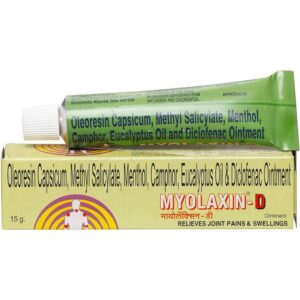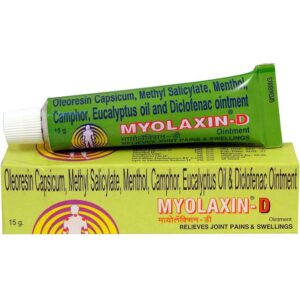EUCALYPTUS OIL + DICLOFENAC DIETHYLAMMONIUM + MENTHOL + METHYL SALICYLATE + CAMPHOR + OLEORESIN CAPSICUM
Eucalyptus Oil: Eucalyptus oil is a natural essential oil derived from the leaves of the eucalyptus tree, specifically species like Eucalyptus globulus or Eucalyptus radiata. It is popularly used for its medicinal properties and has various applications.
Use: Eucalyptus oil is commonly used as a decongestant and expectorant to help relieve the symptoms of respiratory conditions such as bronchitis, sinusitis, and the common cold. It can be used topically for treating muscle and joint pain, as well as for its antimicrobial properties to help alleviate minor skin infections and wounds. Additionally, eucalyptus oil is used in aromatherapy to promote relaxation and clear the mind.
Mechanism of Action: The main active compound in eucalyptus oil is called eucalyptol or cineole. It is responsible for the oil’s mucolytic and bronchodilator properties. When inhaled, eucalyptus oil helps to loosen mucus in the airways, making it easier to cough up. It also acts as a mild irritant, stimulating bronchial secretions and increasing airflow. Topically, eucalyptus oil has analgesic and anti-inflammatory effects, which can help reduce pain and swelling.
Dose: Eucalyptus oil can be used in various forms, including as an inhalation, topical application, or in aromatherapy. For inhalation, a few drops of eucalyptus oil can be added to hot water and the steam can be inhaled for relief of respiratory symptoms. When used topically, it is typically diluted with a carrier oil (such as coconut oil) before being applied directly to the skin. The exact dosage may vary depending on the specific product and the individual’s needs, so it is advisable to follow the instructions provided by the manufacturer.
Side Effects: Eucalyptus oil is generally safe for most people when used appropriately, but it can cause some adverse effects in certain individuals. Possible side effects may include skin irritation, redness, or allergic reactions in some sensitive individuals. Ingesting eucalyptus oil can be toxic and should be avoided. It is important to note that eucalyptus oil should not be used on or near the face of infants or young children due to the risk of breathing difficulties. If any adverse reactions occur, it is recommended to discontinue use and seek medical advice.
Diclofenac Diethylammonium: Diclofenac Diethylammonium is a nonsteroidal anti-inflammatory drug (NSAID) used to relieve pain and reduce inflammation in conditions such as arthritis, osteoarthritis, and rheumatoid arthritis. It is available as a topical gel or cream and is applied directly to the affected area.
The mechanism of action of Diclofenac Diethylammonium involves inhibiting the enzyme cyclooxygenase (COX), which is responsible for the production of prostaglandins in the body. By reducing the levels of prostaglandins, this drug helps to alleviate pain and inflammation.
The usual dose of Diclofenac Diethylammonium is determined by the size of the affected area and ranges from 2 to 4 grams of gel or cream applied 3 to 4 times daily. It is important to follow the instructions provided by your healthcare provider or printed on the packaging.
Like all medications, Diclofenac Diethylammonium can have side effects. Common side effects include skin irritation, redness, itching, and rash at the application site. These side effects are usually mild and temporary. However, in rare cases, more serious side effects such as allergic reactions, severe skin reactions, and liver or kidney problems may occur. If any of these serious side effects occur, it is important to seek medical attention immediately.
It is worth noting that Diclofenac Diethylammonium is for external use only and should not be ingested or applied to broken or damaged skin. It should also be used with caution in individuals with known allergies to NSAIDs or who have a history of stomach ulcers, bleeding disorders, or kidney problems.
As with any medication, it is recommended to consult with a healthcare professional before starting or making any changes to your treatment regimen.
Menthol: Menthol is an organic compound that is commonly used in various products for its cooling and soothing effects. It is extracted from mint plants, particularly peppermint and spearmint.
Menthol has a wide range of uses, including topical application for relief from minor pain, itching, and irritation. It is a popular ingredient in over-the-counter products like cough drops, vapor rubs, and topical analgesics. Additionally, menthol is frequently added to cosmetics, oral care products, and flavored cigarettes.
The mechanism of action of menthol involves activating certain receptors in the body. It binds to transient receptor potential (TRP) channels, specifically TRPM8, which is responsible for sensing cold temperatures. By activating TRPM8, menthol produces a cooling sensation and can temporarily numb or relieve pain.
The dosage of menthol varies depending on the product it is used in. For topical creams, gels, or ointments, it is generally recommended to apply a thin layer to the affected area and massage it in gently. It is important to follow the instructions provided by the specific product and consult a healthcare professional if in doubt.
While menthol is generally considered safe for topical use, it can cause some side effects in certain individuals. These can include skin irritation, redness, and a warming or burning sensation. Allergic reactions to menthol are rare but can occur. Ingesting or inhaling large amounts of menthol can be toxic and should be avoided.
It is important to note that menthol should not be applied to broken or irritated skin, as it may worsen the condition. It is also advisable to avoid using products containing menthol on infants or young children without consulting a healthcare professional.
As with any medication or substance, it is recommended to consult a healthcare professional before using menthol to ensure it is suitable for your specific needs and circumstances.
Methyl Salicylate: Methyl Salicylate is a drug that belongs to the class of nonsteroidal anti-inflammatory drugs (NSAIDs). It is commonly used as a topical analgesic and a counterirritant. Its primary use is to provide temporary relief from muscle aches, joint pain, and minor sprains or strains.
The mechanism of action of Methyl Salicylate involves its ability to produce a cooling sensation, followed by a warming feeling. This is achieved by stimulating the nerve endings near the skin, which in turn helps to distract from and alleviate the pain or discomfort experienced in the muscles or joints. When applied topically, it also helps improve blood circulation in the affected area.
Methyl Salicylate is typically available in the form of creams, gels, or ointments and should only be applied to intact skin. It is important to follow the instructions provided by a healthcare professional or the product label. Generally, it is advised to apply a thin layer of the medication and gently massage it into the affected area until it is absorbed. The frequency of application may vary depending on the severity of the pain, but it is usually recommended to use the drug 3-4 times a day.
While Methyl Salicylate is generally well-tolerated, some individuals may experience certain side effects. The most commonly reported side effects include skin irritation, redness, or a mild rash at the application site. In rare cases, some individuals may develop an allergic reaction to the drug, which can manifest as hives, itching, or swelling of the face, tongue, or throat. It is important to discontinue using the drug and seek medical attention if any signs of an allergic reaction occur.
It is important to note that Methyl Salicylate should not be used on broken skin, open wounds, or near the eyes, mouth, or genital area. It should also not be used on children younger than 12 years old without the guidance of a healthcare professional. Additionally, individuals with certain medical conditions, such as asthma, aspirin sensitivity, or allergies to NSAIDs, should consult with their healthcare provider before using Methyl Salicylate.
Camphor: Camphor is a common medication derived from the camphor tree (Cinnamomum camphora). It is commonly used topically in various forms, such as creams, gels, ointments, and oils, to provide temporary relief from minor aches, muscle pain, itching, and various skin conditions.
The exact mechanism of action of camphor is not fully understood, but it is believed to produce analgesic and antipruritic (anti-itch) effects. It provides a cooling sensation that can help reduce itching and pain. Camphor also has mild antimicrobial properties, making it useful for treating certain skin infections.
Camphor can be applied topically to the affected area as needed, usually up to three to four times a day. It should not be ingested or applied to broken or irritated skin. It is recommended to read and follow the instructions on the product label or consult a healthcare professional before using camphor.
While camphor is generally well-tolerated when used as directed, it can also cause side effects, especially if applied in excessive amounts or ingested. Some common side effects include skin redness, irritation, burning, and allergic reactions such as rash or hives. In rare cases, excessive absorption of camphor can lead to systemic toxicity, which can cause symptoms like confusion, nausea, vomiting, seizures, and even respiratory distress. Therefore, it is important to use camphor cautiously and avoid prolonged or excessive application.
It should be noted that camphor is not recommended for use in infants or children younger than two years old due to the risk of toxicity. Pregnant or breastfeeding women should also exercise caution and seek medical advice before using camphor.
As with any medication, it is important to consult a healthcare professional before using camphor, especially if you have any underlying medical conditions or if you are taking other medications. They can provide appropriate guidance and ensure that camphor is safe and suitable for your condition.
Oleoresin Capsicum: Oleoresin Capsicum, commonly known as pepper spray, is a non-lethal chemical compound derived from hot chili peppers. It is primarily used as a self-defense tool and for riot control by law enforcement agencies.
The active ingredient in Oleoresin Capsicum is capsaicin, which is responsible for the hot and spicy sensation in chili peppers. When used as a spray, it causes immediate and intense irritation of the eyes, respiratory system, and skin.
Pepper spray works by binding to the pain receptors on the skin and mucous membranes, particularly the eyes, nose, and mouth. This activation leads to a burning sensation, causing the eyes to tear up, the nose to run, and difficulty in breathing. It also induces inflammation and swelling of the mucus membranes, temporarily incapacitating the assailant.
The recommended dose of Oleoresin Capsicum varies depending on the specific product, but it is typically sprayed directly towards the face of the perpetrator from a distance of about 6-10 feet. It is important to follow the instructions provided by the manufacturer to ensure effective use and minimize unnecessary harm.
Though considered non-lethal, Oleoresin Capsicum can cause a range of side effects. These can include severe eye and skin irritation, temporary blindness, coughing, difficulty breathing, chest pain, and nausea. In rare cases, some individuals may experience an allergic reaction or asthma attack.
It is worth noting that Oleoresin Capsicum can be used as a self-defense tool, but its use should be within lawful guidelines and regulations. It is also important to use it responsibly and only in situations where it is necessary to protect oneself or others from harm.


